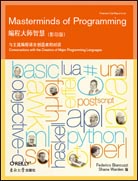
编程大师智慧(影印版)
Federico Biancuzzi, Shane Warden 编
出版时间:2010年09月
页数:480
《编程大师智慧》的主要特色在于它是多位编程语言创造者的独家采访,他们创造的这些编程语言极具历史意义,对于当下的信息社会产生了重大影响。从这部独特的采访集中,你将了解到某些特殊设计决定产生的过程,包括这些先行者当时头脑中的既定目标、他们不得不做的折衷权衡,以及这些宝贵经验至今对编程产生了怎样的影响。本书包括如下采访:
· Adin D. Falkoff: APL
· Thomas E. Kurtz: BASIC
· Charles H. Moore: FORTH
· Robin Milner: ML
· Donald D. Chamberlin: SQL
· Alfred Aho, Peter Weinberger, and Brian Kernighan: AWK
· Charles Geschke and John Warnock: PostScript
· Bjarne Stroustrup: C++
· Bertrand Meyer: Eiffel
· Brad Cox and Tom Love: Objective-C
· Larry Wall: Perl
· Simon Peyton Jones, Paul Hudak, Philip Wadler, and John Hughes: Haskell
· Guido van Rossum: Python
· Luiz Henrique de Figueiredo and Roberto Ierusalimschy: Lua
· James Gosling: Java
· Grady Booch, Ivar Jacobson, and James Rumbaugh: UML
· Anders Hejlsberg: Delphi inventor and · lead developer of C#
如果你对那些用远见卓识和努力工作造就计算机产业的人们感兴趣的话,那么自然会发现
《编程大师智慧》是一本令人着迷的好书。
关于采访者
Federico Biancuzzi是一位自由采访者,他的采访报道发表在多家在线刊物上,包括
《ONLamp》、《NewsForge》、《TheRegister》、《ArsTechnica》 等等。
Shane Warden是一位自由软件开发者,他的主要兴趣在于编程语言设计和虚拟机。在业余时间,他是独立出版社Onyx Neon Press的小说出版部门负责人。他也是O’Reilly图书《敏捷开发艺术》的合著者之一。
· Adin D. Falkoff: APL
· Thomas E. Kurtz: BASIC
· Charles H. Moore: FORTH
· Robin Milner: ML
· Donald D. Chamberlin: SQL
· Alfred Aho, Peter Weinberger, and Brian Kernighan: AWK
· Charles Geschke and John Warnock: PostScript
· Bjarne Stroustrup: C++
· Bertrand Meyer: Eiffel
· Brad Cox and Tom Love: Objective-C
· Larry Wall: Perl
· Simon Peyton Jones, Paul Hudak, Philip Wadler, and John Hughes: Haskell
· Guido van Rossum: Python
· Luiz Henrique de Figueiredo and Roberto Ierusalimschy: Lua
· James Gosling: Java
· Grady Booch, Ivar Jacobson, and James Rumbaugh: UML
· Anders Hejlsberg: Delphi inventor and · lead developer of C#
如果你对那些用远见卓识和努力工作造就计算机产业的人们感兴趣的话,那么自然会发现
《编程大师智慧》是一本令人着迷的好书。
关于采访者
Federico Biancuzzi是一位自由采访者,他的采访报道发表在多家在线刊物上,包括
《ONLamp》、《NewsForge》、《TheRegister》、《ArsTechnica》 等等。
Shane Warden是一位自由软件开发者,他的主要兴趣在于编程语言设计和虚拟机。在业余时间,他是独立出版社Onyx Neon Press的小说出版部门负责人。他也是O’Reilly图书《敏捷开发艺术》的合著者之一。
- FOREWORD
- PREFACE
- 1 C++
- Bjarne Stroustrup
- Design Decisions
- Using the Language
- OOP and Concurrency
- Future
- Teaching
- 2 PYTHON
- Guido van Rossum
- The Pythonic Way
- The Good Programmer
- Multiple Pythons
- Expedients and Experience
- 3 APL
- Adin H. Falkoff
- Paper and Pencil
- Elementary Principles
- Parallelism
- Legacy
- 4 FORTH
- Charles D. Moore
- The Forth Language and Language Design
- Hardware
- Application Design
- 5 BASIC
- Thomas E. Kurtz
- The Goals Behind BASIC
- Compiler Design
- Language and Programming Practice
- Language Design
- Work Goals
- 6 AWK
- Alfred Aho, Peter Weinberger, and Brian Kernighan
- The Life of Algorithms
- Language Design
- Unix and Its Culture
- The Role of Documentation
- Computer Science
- Breeding Little Languages
- Designing a New Language
- Legacy Culture
- Transformative Technologies
- Bits That Change the Universe
- Theory and Practice
- Waiting for a Breakthrough
- Programming by Example
- 7 LUA
- Luiz Henrique de Figueiredo and Roberto Ierusalimschy
- The Power of Scripting
- Experience
- Language Design
- 8 HASKELL
- Simon Peyton Jones, Paul Hudak, Philip Wadler,
- and John Hughes
- A Functional Team
- Trajectory of Functional Programming
- The Haskell Language
- Spreading (Functional) Education
- Formalism and Evolution
- 9 ML
- Robin Milner
- The Soundness of Theorems
- The Theory of Meaning
- Beyond Informatics
- 10 SQL
- Don Chamberlin
- A Seminal Paper
- The Language
- Feedback and Evolution
- XQuery and XML
- 11 OBJECTIVE-C
- Brad Cox and Tom Love
- Engineering Objective-C
- Growing a Language
- Education and Training
- Project Management and Legacy Software
- Objective-C and Other Languages
- Components, Sand, and Bricks
- Quality As an Economic Phenomenon
- Education
- 12 JAVA
- James Gosling
- Power or Simplicity
- A Matter of Taste
- Concurrency
- Designing a Language
- Feedback Loop
- 13 C#
- Anders Hejlsberg
- Language and Design
- Growing a Language
- C#
- The Future of Computer Science
- 14 UML
- Ivar Jacobson, James Rumbaugh, and Grady Booch
- Learning and Teaching
- The Role of the People
- UML
- Knowledge
- Be Ready for Change
- Using UML
- Layers and Languages
- A Bit of Reusability
- Symmetric Relationships
- UML
- Language Design
- Training Developers
- Creativity, Refinement, and Patterns
- 15 PERL
- Larry Wall
- The Language of Revolutions
- Language
- Community
- Evolution and Revolution
- 16 POSTSCRIPT
- Charles Geschke and John Warnock
- Designed to Last
- Research and Education
- Interfaces to Longevity
- Standard Wishes
- 17 EIFFEL
- Bertrand Meyer
- An Inspired Afternoon
- Reusability and Genericity
- Proofreading Languages
- Managing Growth and Evolution
- AFTERWORD
- CONTRIBUTORS
- INDEX
书名:编程大师智慧(影印版)
作者:Federico Biancuzzi, Shane Warden 编
国内出版社:东南大学出版社
出版时间:2010年09月
页数:480
书号:978-7-5641-2262-1
原版书出版商:O'Reilly Media
The cover fonts are Akzidenz Grotesk, Orator, and Helvetica Neue Ultra Light. The text
font is Adobe’s Meridien; the heading font is ITC Bailey.
font is Adobe’s Meridien; the heading font is ITC Bailey.
购买选项